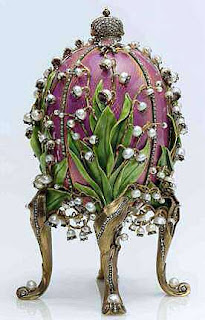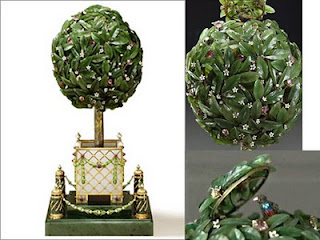What have we heard about the Russian hag witch Baba Yaga? Here is what I know:
- She lives in a hut that stands on chicken legs
- She has iron teeth
- She flies on a mortar & pestle
- She likes to set special tasks for visitors
Doubtless, I have lots to learn. So, beginning with picture books, here's what I will be exploring:
 Bony-legs (Hello Reader Series)
Bony-legs (Hello Reader Series)
by Joanna Cole, Illus. by Dirk Zimmer, 1983.
It states on the copyright page that this version is based on the tale "Baba Yaga" in
Russian Fairy Tales by Aleksandr Afanasev. The child Sasha sets out to borrow a needle and thread for her aunt, but chooses the wrong house to visit. Wicked Baba Yaga plans to eat Sasha, but the girl is aided in her escape by the witch's cat, dog and gate, because she showed them kindness upon her arrival at the hut that stands on chicken feet.
My library's copy of this book is Early Reader rather than Picture Book size which means small but lively illustrations. The Baba Yaga looks like an beak nosed, ugly human woman with scary pointed teeth and nails. This suits this menacing but also comical version of Baba Yaga who intentionally pinches her own nose when she flies into a rage. Pictures are colored primarily pink, orange and yellow over black and white. At the witches house, Zimmer uses patterns of eyes, mushrooms and skulls, as well as the more typical flowers for her wallpaper, tiles and curtains. I love her tub, with beast feet and fish with and without flesh marching around the rim for decoration.
 Baba Yaga: A Russian Folktale
Baba Yaga: A Russian Folktale
retold by Eric. A. Kimmel, Megan Lloyd, Illus.

, 1991.
Kimmel's version of the story is based on an oral tale from the Carpathian mountains that his grandmother told when he was little. It follows the formula of the bad stepmother with an obnoxious daughter sending our heroine, her stepdaughter (here, Marina) to Baba Yaga (here, Auntie-in-the-Forest) to get a needle and thread. The giver of wise advice is a little green frog that Marina meets on the way. A surprising difference is that Marina has a horn growing out of the middle of her forehead. Although her father loves her as she is, Marina asks Baba Yaga to remove the horn. This the witch does, in exchange for the girl boiling some water inside the unusual hut. That begins the familiar cycle of Marina showing kindness to Baba Yaga's neglected household creatures, who aid in her escape. When Marina returns home and tells her father what has occurred, he throws the evil wife and her daughter out of the house. When this girl meets up with the frog, she is rude to it, ends up at the witch's home, and can you guess what happens to Marina's old horn?
The illustrations in this book are more amusing than frightening, maybe because Marina's horn and some of the witch's activities could really come off grotesque if not handled lightly.Aside from her pointy teeth, the Baba Yaga looks like a regular woman, if a hairy legged and unpleasant faced one. The title page shows her filing her teeth, surrounded by her bone fence. When she rides her mortar and pestle, they are small, perched on a broomstick.
 Baba Yaga and Vasilisa the Brave
Baba Yaga and Vasilisa the Brave
by Marianna Mayer, 1994.

 Grandma Chickenlegs (Picture Books)
Grandma Chickenlegs (Picture Books)
by Geraldine McCaughrean
In this version, our child heroine is Tatia, who loses her mother and gains a stepmother who is, you guessed it, wicked. Tatia is made to do all the housework, is fed very little and is sent to "Grandma Chickenlegs" to borrow a needle. Luckily, she has a special doll, Drooga, given to her by her dying mother. At the witch's home, she is required to weave all night, but Grandma certainly intends to eat her up. As in other tellings, she escapes with the aid of Drooga and some magical objects given to her by the hag's cat and dog in repayment for the kindness that she has shown them on her visit. She runs into her father on the road, and her stepmother and stepsisters get their comeuppence. A final happy detail is that the dog and cat come to live with Tatia, her father and Drooga.
Artist Moira Kemp uses lighthearted details that provide comic relief from the tale's darker aspects. Her Grandma Chickenlegs is a matronly figured old gal who dresses in sewing aprons by day and pink bathdrobes, curlers and dotted bloomers by night, but also happens to have green skin, a disturbingly pointed nose and chin, and wears bat wing glasses and spider earrings. An amusing picture on the title page gives us a tufted ear squirrel gazing in surprise at Grandma's iron toothed dentures biting a fallen tree branch.


 Baba Yaga and the Wise Doll
Baba Yaga and the Wise Doll by Hiawyn Oram, Illus. by Ruth Brown


, 1997.
Too Nice Child is pushed out of the house by Horrid Child and very Horrid Child and sent to get a gift from Baba Yaga. She is afraid to go into the forest, but is guided by a doll that her late mother had given her. The witch knows that she is coming and sets her seemingly impossible tasks that she completes with the aid of her doll. She wins the hag's admiration, the gift and gets rid of the nasty children who cast her out and stops being Too Nice and becomes Just About Right.
I love Ruth Brown's illustrations and find her art in
Toad (Picture Books),
 A Dark, Dark Tale (Picture Puffins)
A Dark, Dark Tale (Picture Puffins)
and
Copycat similarly satisfying.

This is a tall, imposing Baba Yaga, with glowing eyes, talon nails and a malleable face. I love her warty, bejeweled toad henchmen, and the double spread picture where they all trot toward Too Nice in the chicken footed hut is priceless. Against the scenes of darkness, we have the child in her simple dress and her reassuringly round-faced, babushka wearing doll. Brown uses a contrast between shadow and golden light, but interestingly, sometimes the shadows are thrown large on the wall by the dolly as she works to help her little friend. I also find it notable that Too Nice, Horrid and Very Horrid appear to be triplets.
I would like to own this one.
Anna and the Seven Swans by Maida Silverman, Illus. by David Small, 1984.

Based on a Baba Yaga tale retold from Russian by Natasha Frumin.
In this tale, Anna is left in charge of her little brother Ivan, but unfortunately, he is carried away by Baba Yaga’s swans. In her search for him, Anna helps an oven, an apple tree and a river of milk with plum jelly banks. When Anna finds her brother at the witch’s house, it soon becomes clear that Baba Yaga has mealtime designs on the children. With the aid of a hungry mouse and the beings that Anna helped on her journey, the siblings safely escape the witch and her familiars.
Caldecott winner David Small lends charming illustrations to the project. Led astray, toddler Ivan spots and follows a large toad that is unnoticed by the other family members. Small draws him as a brave baby, who never seems particularly disturbed by his adventures, as evidenced by his calm wave to his sister as he rides away on a giant swan. Anna is a tenacious little worker, whether carefully using her oven mitt to fetch cherry dumplings from the oven, removing overflowing milk in patterned pitchers or climbing the gnarled chicken leg of Baba Yaga’s cottage. The witch is scrawny under a baggy dress, hook nosed and ill colored. Other fine details are the blowing pastel cottage flowers, the grateful tree’s face and the dear little whiskery mouse.
Baba Yaga by Ernest Small & Blair Lent, 1966.
This version combines Baba Yaga lore from
Russian Wonder Tales by Post Wheeler, 1912,
Old Peter's Russian Tales by Arthur Ransome, 1916,
The Russian Grandmother's Wonder Tales by Mrs. Louise (Seymour), 1906 and
Siberian and Other Folktales by Charles Fillingham Coxwell, 1925.
Marusia loses the money her mother has given her to buy turnips, and has ventured into Baba Yaga's woods to hunt for wild roots. Baba Yaga is on the hunt for bad Russian children to cook in a stew. Captured and put into a pan with potatoes and onions, Marusia is able to put off being eaten by proclaiming her goodness. She is able to watch the ways of the witch for a night and a day, before Baba Yaga discovers that Marusia has lost her family’s money and then back in the pan the girl goes. While waiting, she hears the story of a hedgehog, actually an enchanted Tsarevich, who has been added to the dinner as a last minute treat. The creature/prince knows the location of something that the witch wants, enabling the children to disenchant him and escape the witch’s cooking pan.
It is notable that in this version the children don’t need to be kind or helpful to others to gain their freedom, and in fact, they annoy the witch into sending them home. Instead, many details of supernatural wonder stand out, from the arrival of morning and evening as mysterious horseman, to the magic wishing flower that brings about the birth of the hedgehog/human baby.
Lent’s art appears to be done in a wood block print style. Color is used sparingly, simply in shades from bronze to gold and red to pink. The title page is a lovely balance of Baba Yaga flying in her mortar with her little black cat, stirring the air on either side of her vessel with a broom and a pestle. Underneath and forming a matching semi circle around the title are large, showy flowers.
For online info on this or any fairy or folktale, I refer you to the fabulous SurLaLune website, in this case
the Annotated Baba Yaga Page .

 Faberge Eggs Imperial Russian Fantasies Poster Book
Faberge Eggs Imperial Russian Fantasies Poster Book
 Faberge's Eggs: The Extraordinary Story of the Masterpieces That Outlived an Empire
Faberge's Eggs: The Extraordinary Story of the Masterpieces That Outlived an Empire














